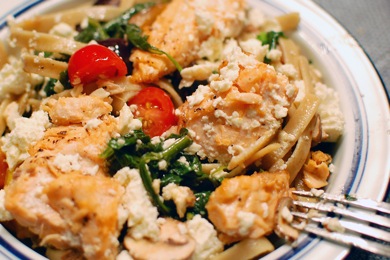I hate those cards handed out by so many different grocery stores everywhere—the cards which supposedly get you special so-called member deals, but which really just help that store keep track of all your purchases. The truth, though, is that these cards can be helfpul—when we still shopped at Kroger our Kroger Plus card came with a monthly coupon and idea booklet that was targeted to our interests specifically. That was nice. Then last week my Plum Market came in even more handy—it won me a store tour led by a locally well known nutritionist, Stacy Goldberg of A Weigh of Life. Although a lot of it was sort of a recap for me, it was a grand old time and came with a free coffee drink (of my choosing, even) and a number of store gifts, including a really cool reusable Plum Market shopping bag. Sweet. Here's a sort of run down of what we talked about during the over one hour store tour:
Produce
We all know we should be eating a lot of fruits and vegetables, but do you really know what that means? The CDC has a fruit and veggie calculator on their website, according to which I, based on my age, gender, and daily activity level, should be consuming 2 cups of fruit and 2.5 cups of vegetables every day. What we talked about with Stacy, standing in the produce department of our local store, was vibrancy; it is important to get all the colors in your diet—green, red, orange, and yellow—over the span of a month, and the darker the color the better. Stacy recommended focusing on one color each week, picking out red vegetables, like red chard and beets, and red fruits, like pomegranates and apples, one week, then orange vegetables the next. Personally, I'd rather mix up my colors over a week, focusing on one color a day (I think I'd get pretty bored of red by Wednesday, but that's just me).
The next question was fresh, canned, or frozen? I think many of us know by now that canned fruits and vegetables are low on the recommendations list, but what about frozen? While fresh vegetables are highly recommended while in season, Stacy recommends frozen as a good alternative to vegetables that you are craving when they are out of season; vegetables that have been frozen were picked at peak ripeness and flash frozen near their growing source, making them a good source of nutrients while also being better for the environment, since they don't require pushing vegetables to grow in unstable environments off season, or being shipped in small quantities several times a week over long distances.
One last tip from Stacy—if you tend to be short on time during the week, preparing vegetables to be cooked or eaten raw (washing, trimming, cutting up) when you bring them home from the store can make you far more likely to take advantage of them throughout the following week.
Protein
Whether you're a vegetarian, a vegan, or an omnivore, protein is a integral part of your diet. In addition to its other values, protein stabilizes blood sugar to help keep you feeling full so you won't over eat throughout the day. Healthy fats also do this, so finding protein sources with healthy fats is like a double whammy. Nuts, seeds, peanut butter, and fish, in particular salmon, are all great sources of protein and healthy fats. Proving once again that it's easier to be healthy if you're rich, Stacy recommended eating salmon 1-2 times per week. Wild caught salmon. In my dreams. The short of it? 20-30% of your total daily calories should come from protein.
Grains
They word of the day is whole, as in whole grains. Whole grains are higher in fiber, and fiber is good for your body. It can get tricky, though—buying bread that says "whole wheat" does not mean that it is made with 100% whole grains. The best way to shop for the healthiest grain products is by looking for the new 100% whole grain stamp. Again, it can be tricky—there are two different stamps, one that simply says "whole grain," implying at least 8g of fiber per serving, and one that says "100% whole grain." The latter, of course, is the one you're looking for, although either is a better choice than a product of only refined grains.
The other shocker about pasta? Portion distortion—an appropriate portion of pasta isn't that plateful of spaghetti you've been enjoying for dinner, an appropriate portion of pasta is merely 1/3 of a cup. Yep, that's it. Enjoy it.
Nutritional Density
This was the ultimate message I came away with after the tour with Stacy: whenever we choose a food, whether for a snack, a breakfast, a lunch, or a dinner, the key is to choose one with the greatest benefits and the lowest junk content. Look for foods with a good level of protein, fiber, and nutrients, but a low level of sugars and fats. Think of it as your own personal food bank—where do you want to spend your daily allowance of sugar? How about your daily allowance of fats?
Here's an eye-opener of an example: many people reach for a flavored yogurt as a good protein option, especially for a snack or at lunchtime, but flavored yogurts have a relatively high sugar content, many of them upwards of 20g. Since a large chocolate chip cookie has about the same sugar content (!), I'm guessing that most of us wouldn't choose a yogurt to be our sugary treat for the day. If you were choosing that yogurt as a healthy source of protein you might want to look elsewhere for a protein that won't cost you so many sugar dollars (like a handful of nuts), or for a healthier yogurt option. And eating that chocolate chip cookie is a good thing, as long as it's budgeted in—making foods off limits can just make us want them all the more.
My favorite key phrases of the day: It's less about what you eat, and more about how much and how often; eat a vibrant diet rich in deeply colored produce; where do you want to spend your sugar and/or fat dollars each day?

 Health,
Health,  Recipes | tagged
Recipes | tagged  All in one,
All in one,  Main Dishes,
Main Dishes,  Seafood
Seafood 


